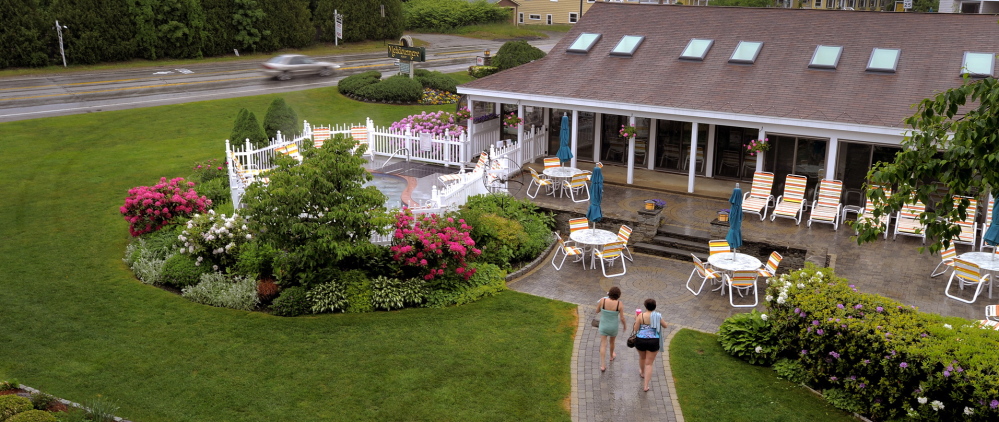HARBORSIDE — Urban streams are dangerously polluted from pesticide runoff, according to a report released Sept. 11 by the U.S. Geological Survey as part of its National Water Quality Assessment Program. Reasons for exceeding benchmarks are not specified, but the obvious source of contamination in municipal areas is lawn-care chemicals. Two of the insecticides cited by USGS as above safe levels for fish (fipronil and dichlorvos) are primarily for landscaping and household applications.
Unaccountably, the most commonly used lawn herbicides – 2,4-D (Weed ‘n Feed) and glyphosate (Roundup), highly toxic to all life forms – were not assessed. Nor did USGS scientists monitor fungicides, pyrethroids and neonicotinoid insecticides applied to kill grubs – chemicals that are decimating the bees on which we depend for pollination of food crops. It is expensive to sample for these compounds, yes, but arguably more costly not to do so.
Bees are deprived of essential nectar sources when Roundup is sprayed on “weeds” like dandelion and clover. Glyphosate and the deadly surfactant it contains (polyoxyethylene tallow amine) are toxic to humans, too. The formulation is linked to cancer, endocrine disruption and reproductive abnormalities, and several recent studies reveal alarming evidence of intestinal damage from soil-borne pathogens it creates, especially when used on herbicide-tolerant genetically modified crops.
As Roundup Ready grass is scheduled to be marketed in 2015, the pesticide now poses an even greater threat. This will mean destruction of beneficial soil organisms and cross-contamination of non-GM plants as well as proliferation of superweeds resistant to Roundup and requiring still more toxic herbicides that will inevitably end up in water.
The problems are already manifest with Roundup Ready food crops, and will escalate when crops are genetically modified to withstand massive spraying of 2,4-D, approved by the U.S. Department of Agriculture earlier this year.
We cannot be reassured by USGS researchers’ conclusions that the pollution of drinking water sources is declining. Key factors like the toxicity of many agricultural insecticides, fungicides and herbicides – both acute and chronic – have not been taken into account; and the effects of complex chemical mixtures remains to be assessed.
It is essential that we be made aware when maximum contaminant levels of compounds known to cause harm – regrettably regulations are more protective of the chemical industry than of humans and the environment – are over the limit.
With federal regulation proceeding at a glacial pace, responsibility for precautionary action lies squarely in the hands of citizens and their municipal officials.
The town of Ogunquit is not waiting for more study before taking steps to protect water and the health of residents. An amended version of the ordinance approved there in June, which prohibits cosmetic use of pesticides, will be back on the ballot in November.
With passage of this law, Ogunquit will be the first town in Maine (and second in the nation, after Takoma Park, Maryland) to ban lawn-care chemicals on private as well as public land. The action these officials have taken acknowledges that cities and towns have the power to keep toxic effluents out of lakes, rivers and bays.
Their power to control contingencies like rising sea levels and superstorms is limited, however, so emergency preparedness, especially along the coast, is critical. Our two states’ recreation industries are a vital economic engine – too important to allow pesticide runoff to contaminate wells and reservoirs and to compromise the safety of fishing, boating and swimming.
Because we all live downstream, lawns must be weaned off the costly, chemical-intensive life support provided by industrial landscapers. With organic pest management – building up soil with compost and aerating, aided by earthworms – turf can be 50 percent more cost-effective after three years than chemical programs.
Replacing part of a sterile lawn with ground covers such as ornamental native grasses, bushes and flowers adds varied visual interest, provides sustenance to bees and other pollinators and cuts down on the pollution and expense of mowing.
According to the Union of Concerned Scientists, a power lawnmower emits as much smog-forming pollution in one hour as a car traveling almost 200 miles.
These are the costs Ogunquit and Takoma Park have determined to avoid. The U.S. Geological Survey would do well to note their progress.
— Special to the Telegram
Send questions/comments to the editors.


